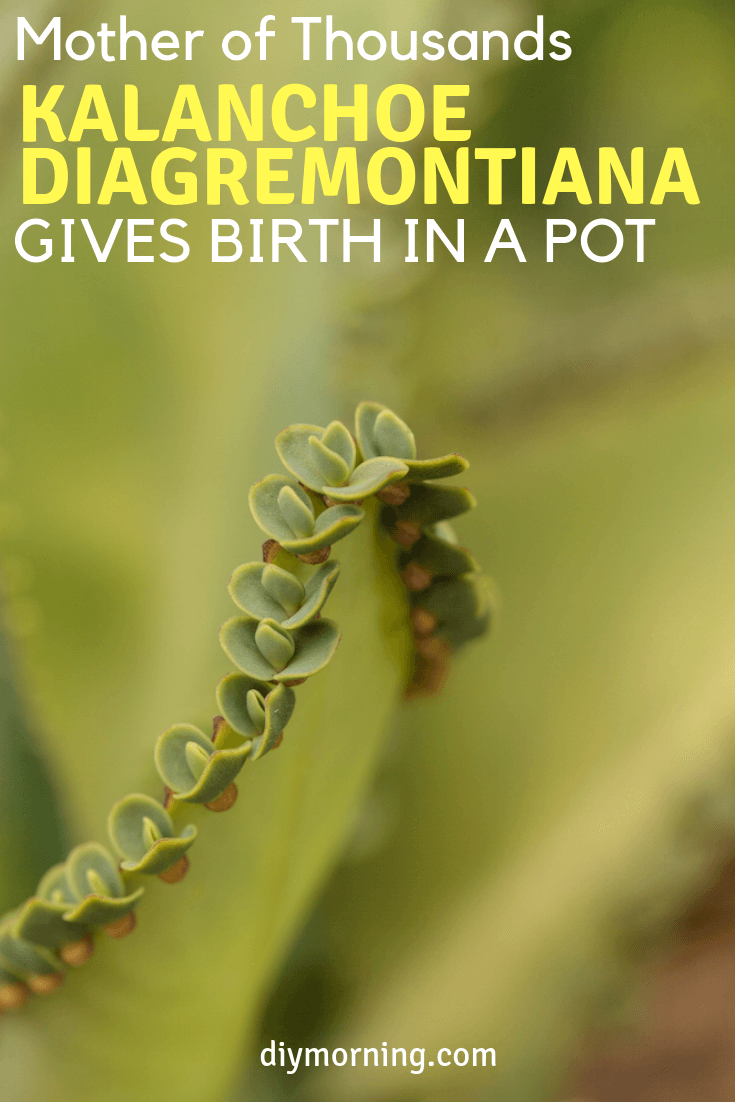Supermom succulent Kalanchoe diagremontiana often called ‘Mother of Thousands’ is a stay at home houseplant prodigiously propagating viviparous plantlets.
Mother of Thousands suggests the gardener’s version of the nursery rhyme ‘There was an Old Woman Who Lived in a Shoe.’
A green mother of thousands lived in a pot
With so many plantlets, what’s a gardener to do?
Give them sunlight and water but not a lot
Then repot the offspring and pass along to you.
Table of Contents
Prodigious Plantlets
This mom produces prodigious plantlets along its leaf margins, clonal babies with the same reproductive prowess as their mom. Although this marginal mom sends the blatant message of reproduction being the raison d’etre, scientists would add that Kalanchoe diagremontiana has adapted to circumstances beyond its control.
According to recent plant researchers at the University of California – Davis, Mother of Thousands has lost the ability to make viable seed in the way angiosperms do. Genetic testing produced evidence that Kalanchoe diagremontiana has transferred the embryo-making process to the leaves. Reproducing vegetatively was the mechanism put in place for survival.
Kalanchoe has another survival tactic: poisons. The plant stem, leaves, roots, and especially the flowers contain cardiac glycosides which are toxic if ingested by humans, pets, and livestock.
The common houseplant should be kept away from young children and household pets including cats, dogs, birds, and rabbits.
The plant is found in the houseplant section of most garden centers under any one of its common names: alligator plant, Mexican hat plant, mother of thousands, mother of millions, devil’s backbone and flea plant.
Silhouette of Kalanchoe Diagremontiana
The perennial Stone crop family member from Madagascar can reach 2-3 feet in height. Stems and leaves are light to medium green with markings of pink to purple. The margins of leaves have bulbiliferous spurs that issue plantlets with roots.
Sometimes these indoor plants send forth a flower stalk with nodding tubular pink, red or purple flowers in the growing season but this is not an annual occurrence nor predictable.
Growing Kalanchoe Diagremontiana as a Houseplant
Mother of Thousands is easy to grow. It thrives in bright light or full sun. A south facing window is best but eastern and western exposures will suffice. If placed outdoors in summer, provide a sunny location with some protection from midday sun which can scorch the leaves.
Water thoroughly when dry but do not overwater. Allow top 2 inches of soil to dry between waterings. Water less frequently in winter. Make sure the planting pot has drainage holes.
Feed frugally from spring to fall with a liquid fertilizer diluted by half.
Growing medium can be a blend of soilless potting mix with 50 per cent perlite or coarse sand. Cactus potting media works well too.
Repot only when the succulent outgrows its pot; never over-pot Kalanchoe.
The succulent is comfortable at room temperatures of 60°F to 75°F with average indoor humidity.
Mother of Thousands grows outdoors year-round in USDA zones 9b-11.
Propagating Kalanchoe
Although plantlets drop off the mother plant and take hold wherever they fall, you may direct the population explosion by placing plantlets in flats of moistened potting medium until they reach the desired size for gifting or transferring to a larger pot.
In some tropical and subtropical climates where the plant grows outdoors, Mother of Thousands has become an invasive species. Even as an indoor plant one may find plantlets growing in the soil of adjacent houseplants.
Uses of Kalanchoe Diagremontiana
This is a low cost and fun plant to use in demonstrating and teaching vegetative propagation. Succulent adaptations for survival are also important teaching topics.
Scientists consider the plant a model for the study of somatic embryogenesis in nature.
Effortless Mother of Thousands makes its owner look like a green thumb.
Sources
- Lemke, Cal. ‘Kalanchoe Diagremontiana Mother of Thousands’ on Cal’s Plant of the Week website from University of Oklahoma Department of Botany and Microbiology, September 15-21, 2006.
- Mellichamp, Larry and Paula Gross. Bizarre Botanicals: How to Grow String-of-Hearts, Jack-in-the-Pulpit, Panda-Ginger, and Other Weird and Wonderful Plants.Portland: Timber Press, 2010.
- University of California, Davis. “How ‘Mother Of Thousands’ Makes Baby Plants.” ScienceDaily, 2 Oct. 2007. Web. 19 Nov. 2011.
- Smith, Geof. ‘Kalanchoe Species Poisoning in Pets.’ in Veterinary Medicine, November 2004. Web. 19 Nov. 2011.





